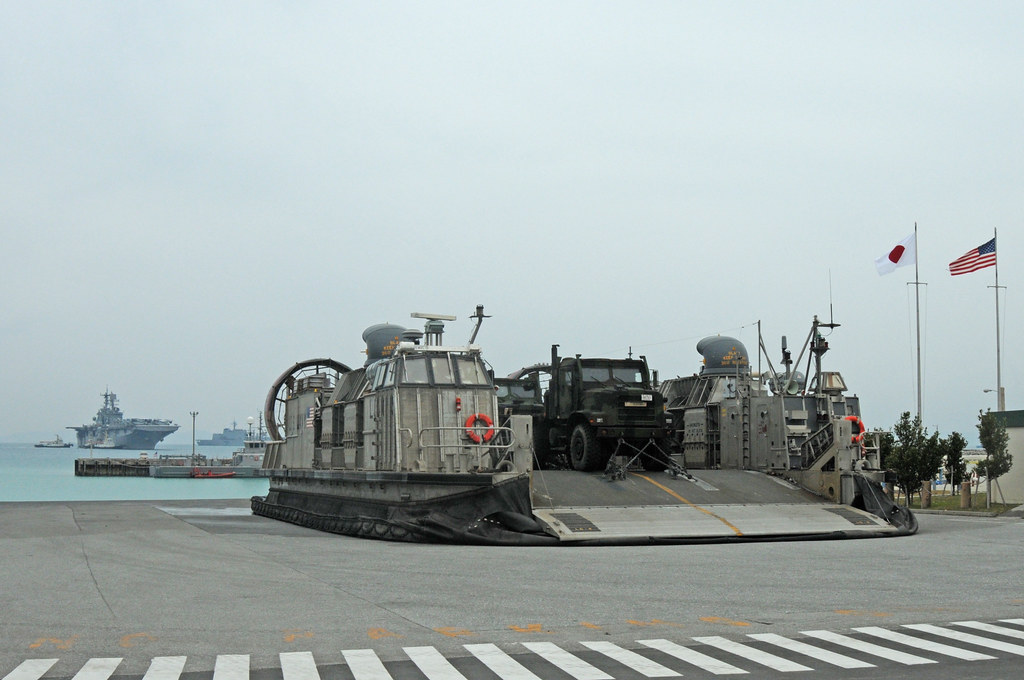From USS Bonhomme Richard Public Affairs
<< EAST CHINA SEA (April 11, 2014) A CH-47F Chinook tandem rotor heavy-lift helicopter, assigned to the 3rd General Support Aviation Battalion, 2nd Infantry Division, conducts flight operations with the amphibious assault ship USS Bonhomme Richard (LHD 6). Bonhomme Richard is the lead ship of the Bonhomme Richard Amphibious Ready Group and is conducting joint force amphibious operations in the U.S. 7th Fleet area of responsibility with the 31st Marine Expeditionary Unit (31st MEU) and Commander Amphibious Squadron 11. (U.S. Navy photo by Mass Communication Specialist 2nd Class Michael Achterling/Released) [Image: Flickr User - Naval Surface Warriors]
WATERS TO THE EAST OF THE KOREAN PENINSULA (NNS) -- The amphibious assault ship USS Bonhomme Richard (LHD 6) transported Marines from the 31st Marine Expeditionary Unit (MEU) to the coast of the Republic of Korea (ROK) in support of the Korean Marine Exchange Program (KMEP) 2015.
One major characteristic that makes Bonhomme Richard and the other ships of the Amphibious Ready Group (ARG) unique is their ability to move hundreds of personnel and haul heavy equipment to and from the shore quickly, but none of this would be possible without the landing craft air cushion (LCAC) and landing craft utility (LCU) of Naval Beach Unit (NBU) 7.
"The whole reason we have an amphibious assault force is to get our forces ashore and the LCAC plays a vital role in that mission," said Lt. j.g. Nelly Ruiz, NBU-7 officer in charge.
All sea bound traffic to and from Bonhomme Richard must go through the well deck, which is an entrance/exit in the aft portion of the ship very similar to the drawbridge of a medieval fortress.
Boatswain's Mate 1st Class Paul Lembo, Bonhomme Richard's well deck control officer, much like an air traffic controller, is the eyes and ears for the bridge team during well deck operations.
"With the well deck we have the capability of being able to put troops and supplies on almost any beach in the world," said Lembo. "In addition to launching and recovering all amphibious craft, the well deck team is also comprised of signalmen who visually communicate with each craft, as well as traffic control men who are responsible for the on and off load of vehicles and personnel."
AAVs, or amphibious assault vehicles, are capable of getting Marines ashore without the help of the LCACs and LCUs are capable of carrying larger payloads than the LCACs, but the LCACs have one distinctive advantage over both of these vehicles.
Okinawa, JAPAN (Mar. 4, 2015) A Landing Craft Air Cushion (LCAC 9) assigned to Naval Beach Unit (NBU) 7 is loaded and staged as the amphibious assault ship USS Bonhomme Richard (LHD 6) pulls into White Beach Naval Facility, Okinawa. Bonhomme Richard, flagship of the Bonhomme Richard Amphibious Ready Group (ARG) with embarked Amphibious Squadron (PHIBRON) 11 and the 31st Marine Expeditionary Unit (MEU) are on deployment to the U.S. 7th Fleet area of operations supporting security and stability in the Indo-Asia-Pacific region. (U.S. Navy photo by Lt. David Levy/Released) [Image: Flickr User - U.S. Pacific Fleet] >>
"Our greatest asset is our speed," said Naval Aircrewman (Mechanical) 1st Class Erik Wilt, NBU-7 navigator. "The LCAC can travel at speeds of up to 50 knots and can quickly move vehicles, cargo and troops from the ship to the shore."
As the Bonhomme Richard Amphibious Ready Group (ARG), composed of Bonhomme Richard, the amphibious transport dock ship USS Green Bay (LPD 20), the amphibious dock landing ship USS Ashland (LSD 48) and the 31st Marine Expeditionary Unit (MEU) participate in KMEP, the equipment transported includes: high mobility multipurpose wheeled vehicles, medium tactical vehicles, M1161 internally transportable vehicles, light armored vehicles and, other equipment between Marine Prepositioning Forces (MPF) and Navy assets.
"So far at this point in the deployment my craft alone has carried over 2 million lbs. of Marine Corps vehicles, cargo and passengers to the shore," said Wilt. "With one LCU we can move 350 troops to the beach at one time, ready for action."
KMEP is designed to strengthen the interoperability in amphibious operations between the U.S. and Republic of Korea (ROK) Forces, which contributes to the security and stability on the Korean Peninsula as well as the entire Asia-Pacific region.
Bonhomme Richard, with embarked Commander, Expeditionary Strike Group 7, Rear Adm. Hugh Wetherald, Commander, Amphibious Squadron 11, Capt. Heidi Agle and their staff are on patrol in the U.S. 7th Fleet area of operations providing security and stability to the Asia-Pacific region.


